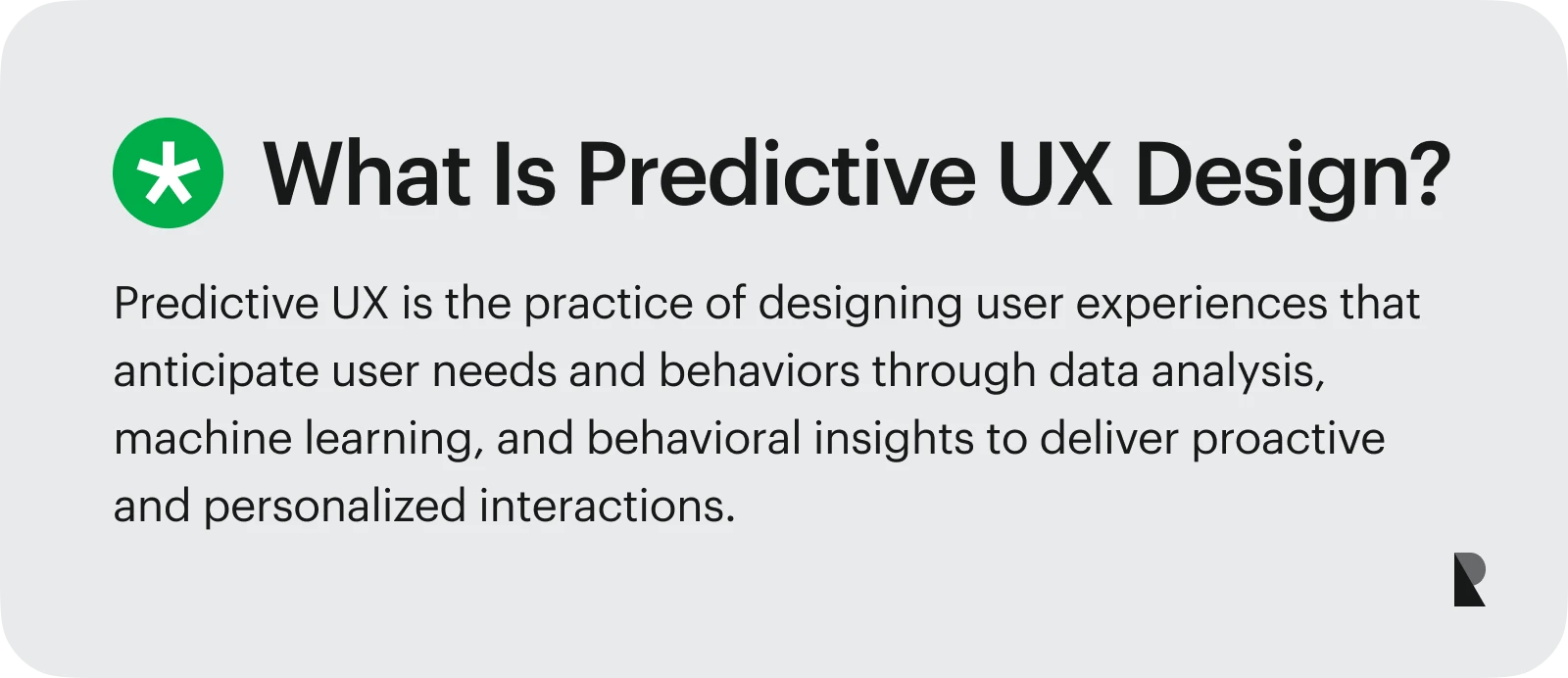
Traditional approaches to design often react to user actions. However, new techniques are emerging that anticipate users’ actions and create the desired user experience before they even ask for it. This is where predictive UX comes into play.
Predictive UX leverages anticipatory approaches based on data-driven insights to provide a better user experience. With the help of predictive models, designers create more personalized interactions, wrestling with innovative designs that mirror real-world behaviors.
As users are exposed to more products and their needs evolve, predictive UX is quickly becoming a necessity for digital designs. Predictive UX design promises to deliver quality, seamless experiences, and enrich the overall design by meeting the myriad needs of the audience.
In this article, we explore the concept of predictive UX design, its significance, and common use cases.
Read along as we discuss how to anticipate users’ needs.
What Is Predictive UX and Why Does It Matter
Predictive UX is an anticipatory approach to design in which researchers and designers employ predictive models to meet users’ needs. The unique aspect of predictive UX design is that it identifies and meets users’ expectations before they even ask for it, thus delivering a seamless user experience.
What is predictive UX design?
Predictive user experience design refers to anticipating users’ needs and proactively guiding their interactions. Predictive UX uses artificial intelligence and machine learning to create engaging, personalized, intuitive experiences.
In predictive UX, designers can learn from users’ behaviors and draw clear explanations regarding the process. This approach to design relies on several essential principles to deploy the predictive models and enhance the overall experience. These principles are as follows.
- Anticipating users’ needs
- Adapting the design based on context
- Minimizing cognitive load
- Learning from users’ actions and behaviors
By using these basic principles, designs can predict the future, such that an app might suggest the next best step for users or an entire system adjust to users’ behaviors. This anticipation makes users' lives easy and ensures that they get the right content at the right time and in the right manner.
The overall goal of predictive UX is to deliver solutions to the users efficiently and effectively. The resulting user experiences are proactive and intuitive, giving a natural feel. This is where knowledge and understanding of predictive UX can come in handy.
The shift toward predictive UX highlights how design and machine learning increasingly intersect. Companies that embrace this change stay ahead of evolving user expectations. Working with a custom UI/UX design company allows product teams to integrate predictive design models effectively — combining AI-driven insights with creative strategy to deliver future-ready digital experiences.
How Predictive UX Works
Predictive UX combines methods and techniques, such as predictive analytics, artificial intelligence, and machine learning, to deliver proactive designs. It all starts by gathering quality data about the users’ needs, expectations, and behaviors. Designers and researchers can use this information to build predictive models and create innovative user experiences in the real world.
Data, AI, and machine learning
Researchers collect data from multiple sources, including user journeys, browsing histories, bounce rates, click-through rates, and heatmaps. The data helps designers make appropriate content recommendations for the target audience.
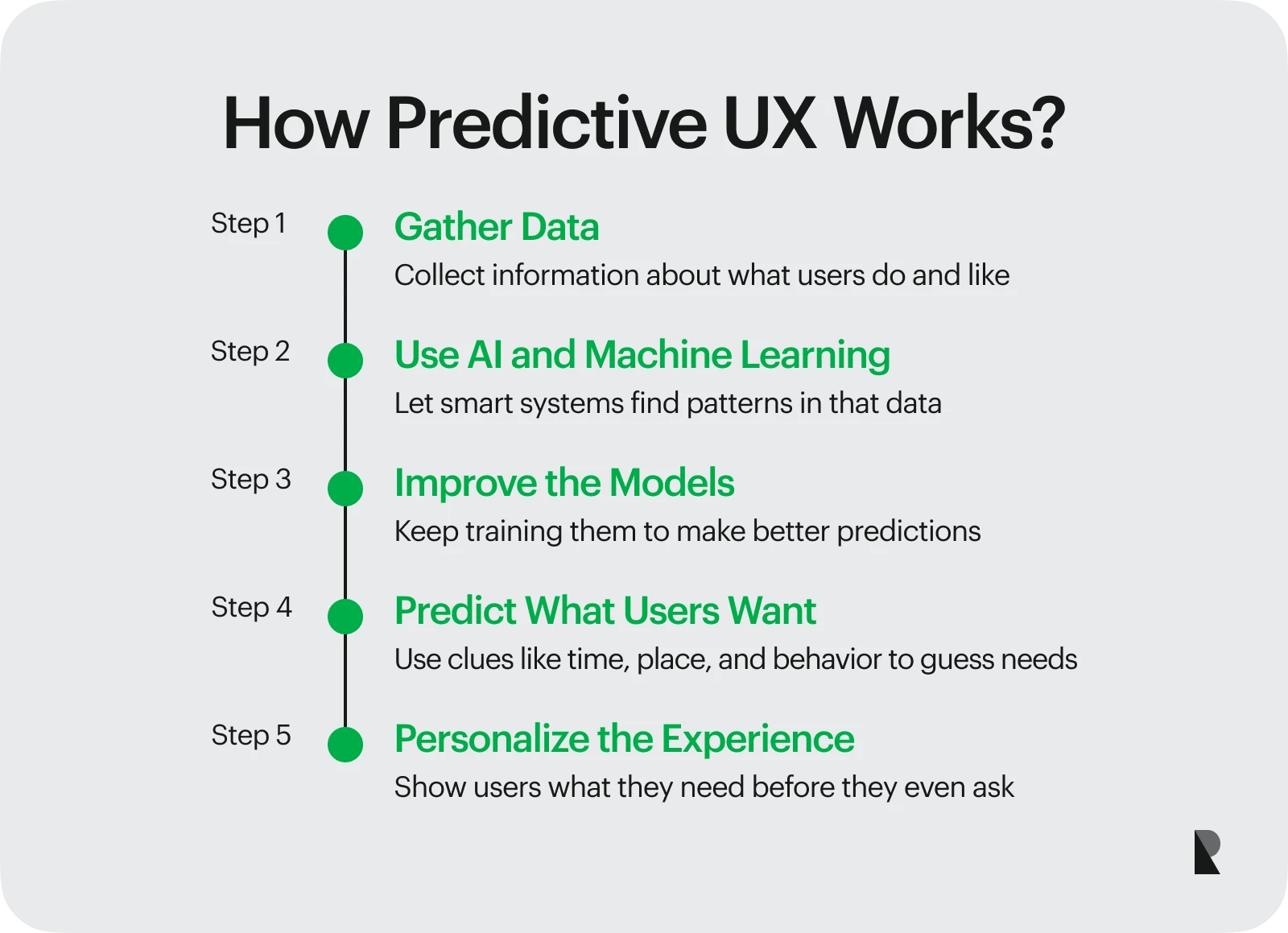
The data gathered is then used to develop effective machine learning models that learn from users’ behaviors and interactions. These machine learning models and algorithms refine the data, account for inconsistencies, and help predict the future.
Anticipating user intentions
The anticipation of users’ intent considers all the data, along with micro-interactions and signals, such as search terms and location for context. The machine learning models must account for all the big and small factors to predict users’ actions accurately.
For example, streaming platforms predict and show content based on location and what is trending in a certain region at a time. Similarly, online shopping websites use festivals and times of the year, along with browsing history, to provide suitable content recommendations.
Key Elements of Predictive UX Design
Predictive UX design has some key elements that help deliver quality user experiences. From data collection to context-based recommendations and iteration, these elements help make informed predictions. The key elements discussed below, along with artificial intelligence and predictive analytics, ensure a more personalized and proactive approach to user experience design.
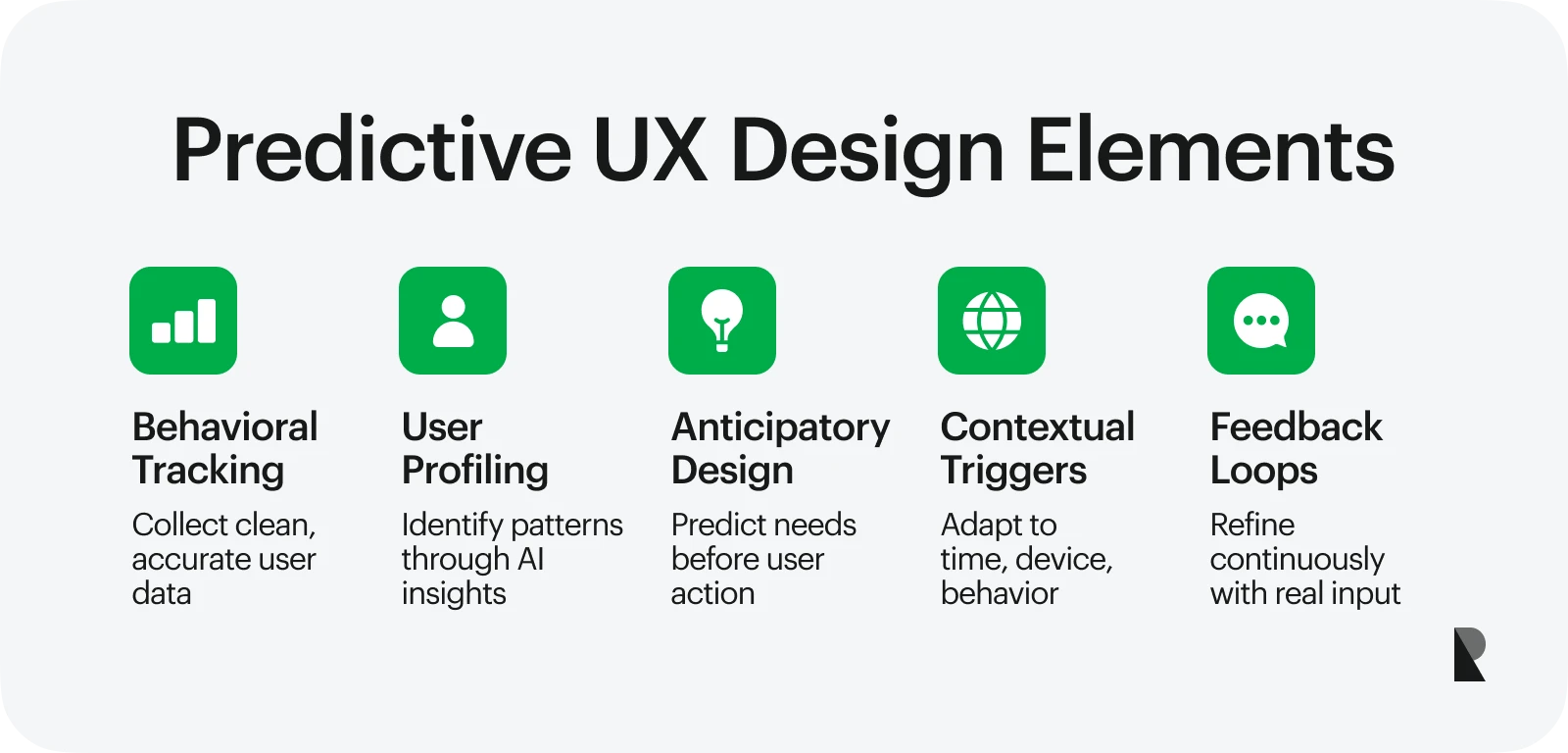
Behavioral tracking and data collection
Predictive UX starts with collecting quality data that can provide helpful insights into users’ behavioral patterns. Designers, researchers, and even the best machine learning models cannot make predictions without this fundamental data.
For predictive UX, it is important to gather information about how users interact with the content, including the journey map, content preferences, likes and dislikes, location, and time. It is also critical to focus on the accuracy of this data. Clean and accurate data can help build efficient and reliable models.
User profiling and pattern recognition
After data collection, the next important step is to develop user profiles by analyzing their past interactions, interests, and contextual factors. These profiles are processed with the help of artificial intelligence and machine learning models to strengthen informed predictions meeting the contextual needs of the target audience.
User profiling also helps in pattern recognition. Based on the patterns in user behavior and the matching elements in their interactions, predictive analytics helps shape user experiences to make them more personalized for a specific group.
Anticipatory design and contextual triggers
Anticipatory design, another key element of predictive UX, involves preparing and delivering content recommendations and an appropriate user experience before users request them. This is where the informed decisions of predictive models come in, helping streamline the user journey.
Anticipatory design relies heavily on critical contextual triggers, such as the device used to interact with the content, the time of day when the interaction happened, and the browsing or interaction history.
Feedback loops and continuous learning
Like any UX design approach, predictive UX is nothing without iteration, feedback, and improvement. It takes users’ actions into account, making sure that the changes in their behaviors and evolving needs are incorporated into the system’s learning process.
With time, this new information and algorithm changes lead to refinement. For example, an app might need to adjust the content quality or its delivery mode based on users’ preferences. The feedback-driven process keeps predictive UX relevant and practical.
Benefits of Predictive UX
Predictive UX has significant advantages over traditional design approaches. By creating personalized and intuitive user experiences with the help of predictive analytics and predictive models, businesses can anticipate user needs and deliver quality products and services.
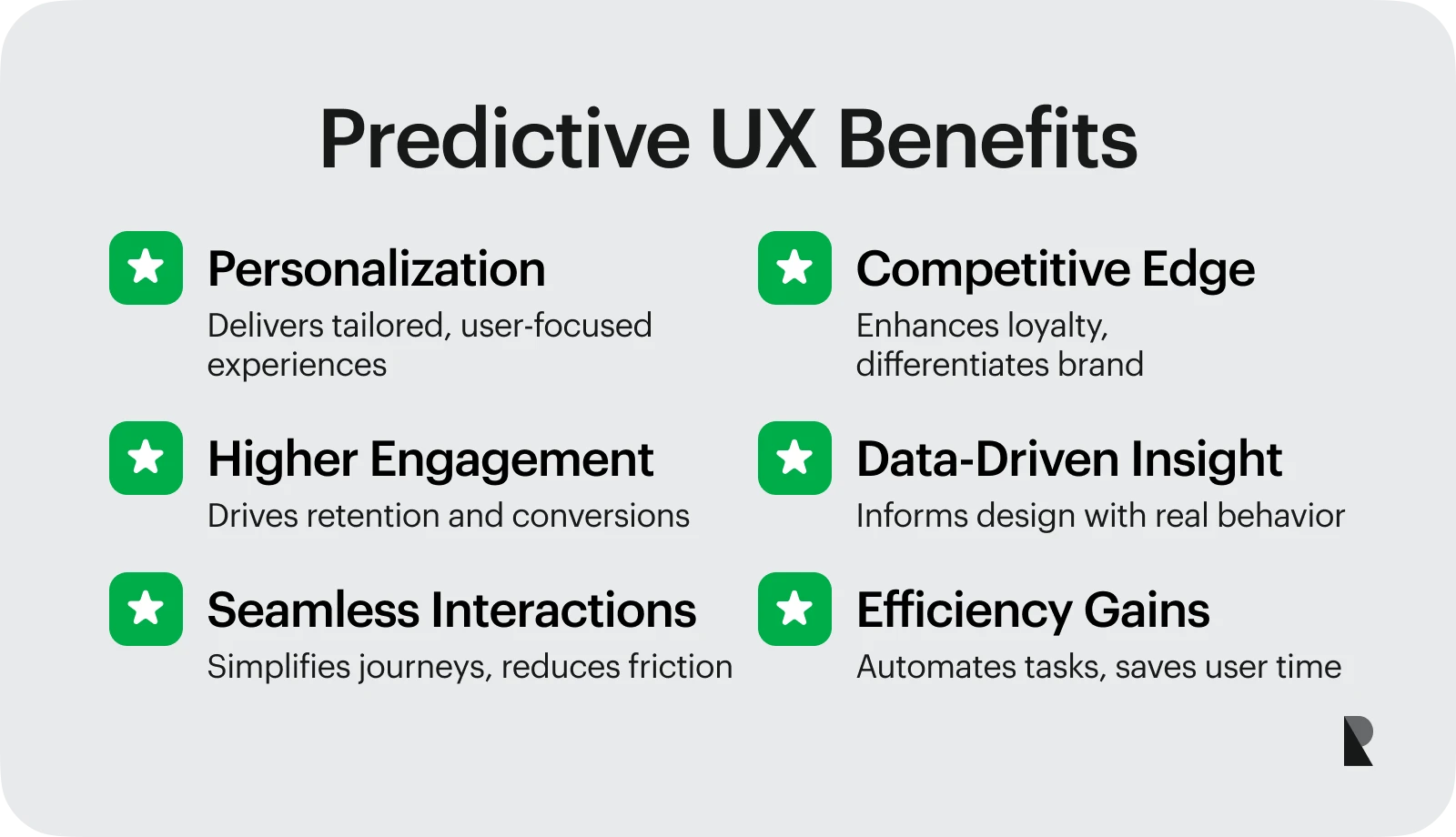
Some essential benefits of leveraging predictive UX in today’s digital environment are as follows.
Personalization and user satisfaction
Personalization is a key benefit of predictive UX design. With the help of predictive models, designers and researchers can create personalized experiences for the target audience. When users get a tailored experience, their overall satisfaction increases. For example, a streaming app might anticipate a user’s likes and provide more recommendations.
Engagement and conversion rates
Predictive UX also helps improve engagement and conversion rates. Accurate predictive models lead to a higher click-through rate, which in turn leads to better retention. For example, a travel app might use AI to recommend hotels or itineraries at the perfect moment, boosting results for both user and business.
Intuitive and seamless interactions
Another essential benefit of predictive UX is that it shortens the user journey by improving the efficiency of their tasks. Designs leveraging predictive models can help users perform complicated tasks in fewer steps, making the overall experience smoother and more convenient.
Common Use Cases of Predictive UX
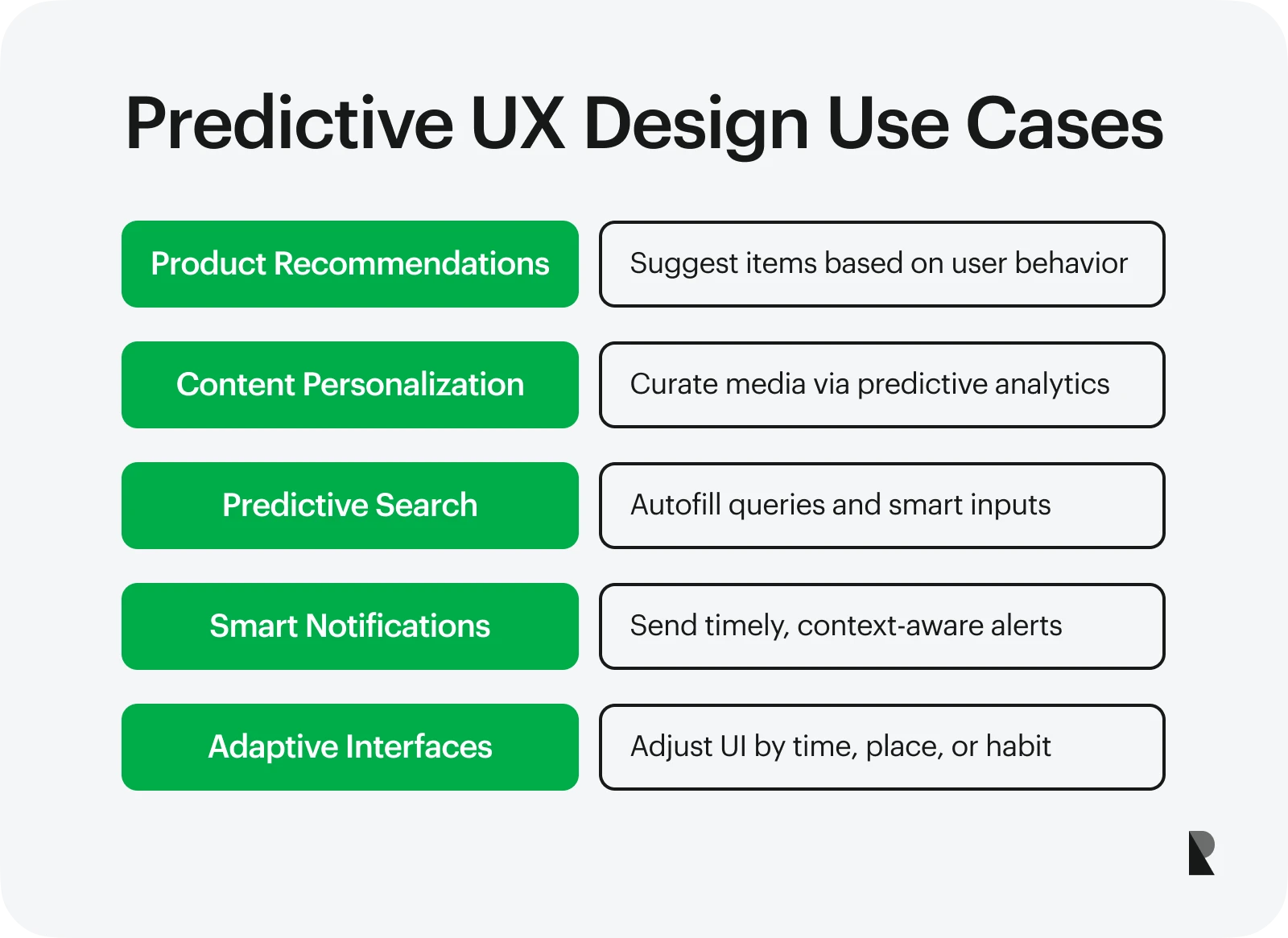
There are several real-world examples of products and services that implement predictive models and predictive analytics to create personalized user experiences. Some notable examples are discussed below.
Product recommendations in e-commerce
E-commerce and online shopping platforms leverage predictive models to improve users' overall purchasing journeys in a highly concentrated digital environment. By analyzing browsing history, previous purchases, and behaviors, they can offer personalized recommendations. For example, Amazon and Walmart use predictive models to highlight items that users might be interested in.
Content personalization in streaming
Streaming platforms also use predictive analytics to recommend the content a user might be interested in. For example, Netflix and Prime Video suggest movies and TV shows, YouTube creates a personalized homepage for users, and Spotify uses its predictive models to tell new (and old) music to listeners.
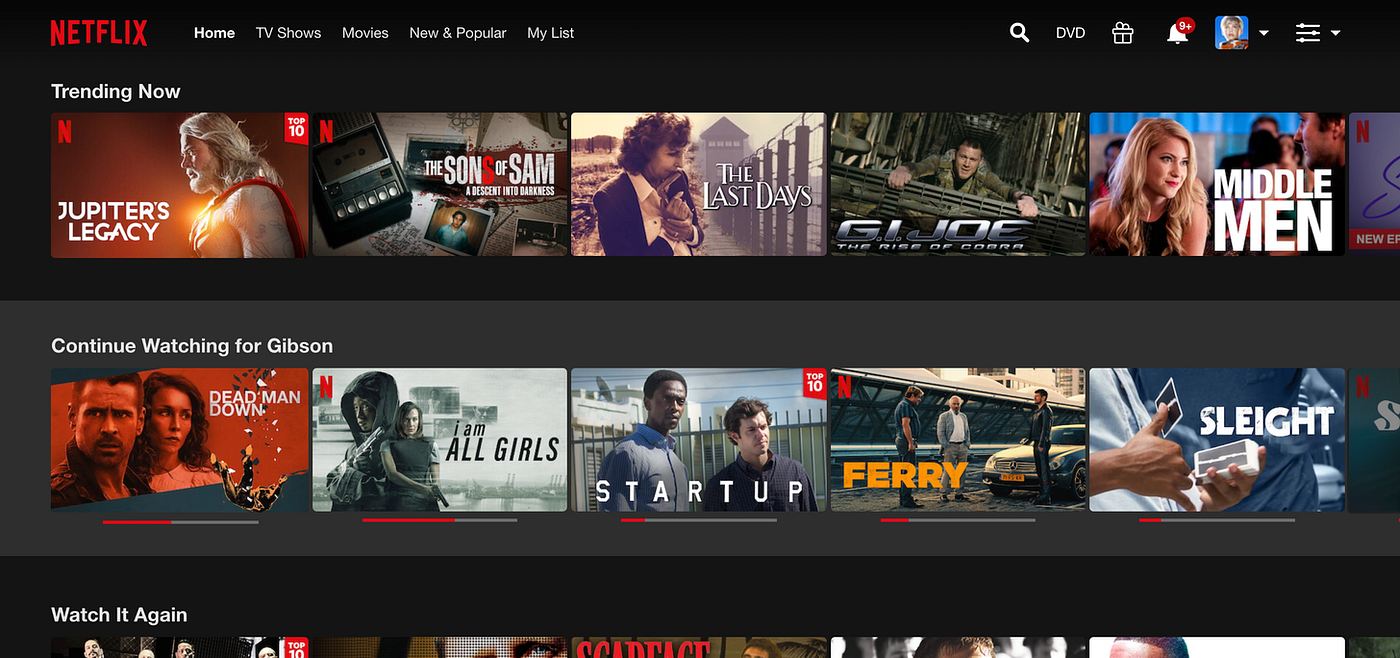
Netflix Personalized Recommendations (Image Source)
Predictive search and autofill
Another use case of predictive UX can be found in search and input systems. All modern search engines use predictive models, which suggest autofill based on recent trends, users’ search history, and browsing patterns. Google’s search bar is a prime example of this use. Additionally, innovative forms suggesting addresses and passwords, and chatbots suggesting replies, also work well because of predictive UX.
Smart notifications and reminders
Modern successful apps also use predictive analytics to send timely reminders and smart notifications to their users. The timing and quality of such notifications can lead to quicker and better decisions. For example, food delivery apps like Uber Eats and DoorDash may suggest dinner options at peak hours. Similarly, credit card apps notify about payments and due dates.
Adaptive interfaces by context
Powered by predictive models, digital interfaces adjust and adapt based on the use context. They adapt based on the time of day, location, or similar preferences. iOS devices switching to a “Work” focus when the user is at the workplace is one such example.
Ethical and Privacy Concerns
On the one hand, the use of predictive models and analytics helps create improved, personalized experiences. On the other hand, the use of predictive UX also raises ethical considerations.
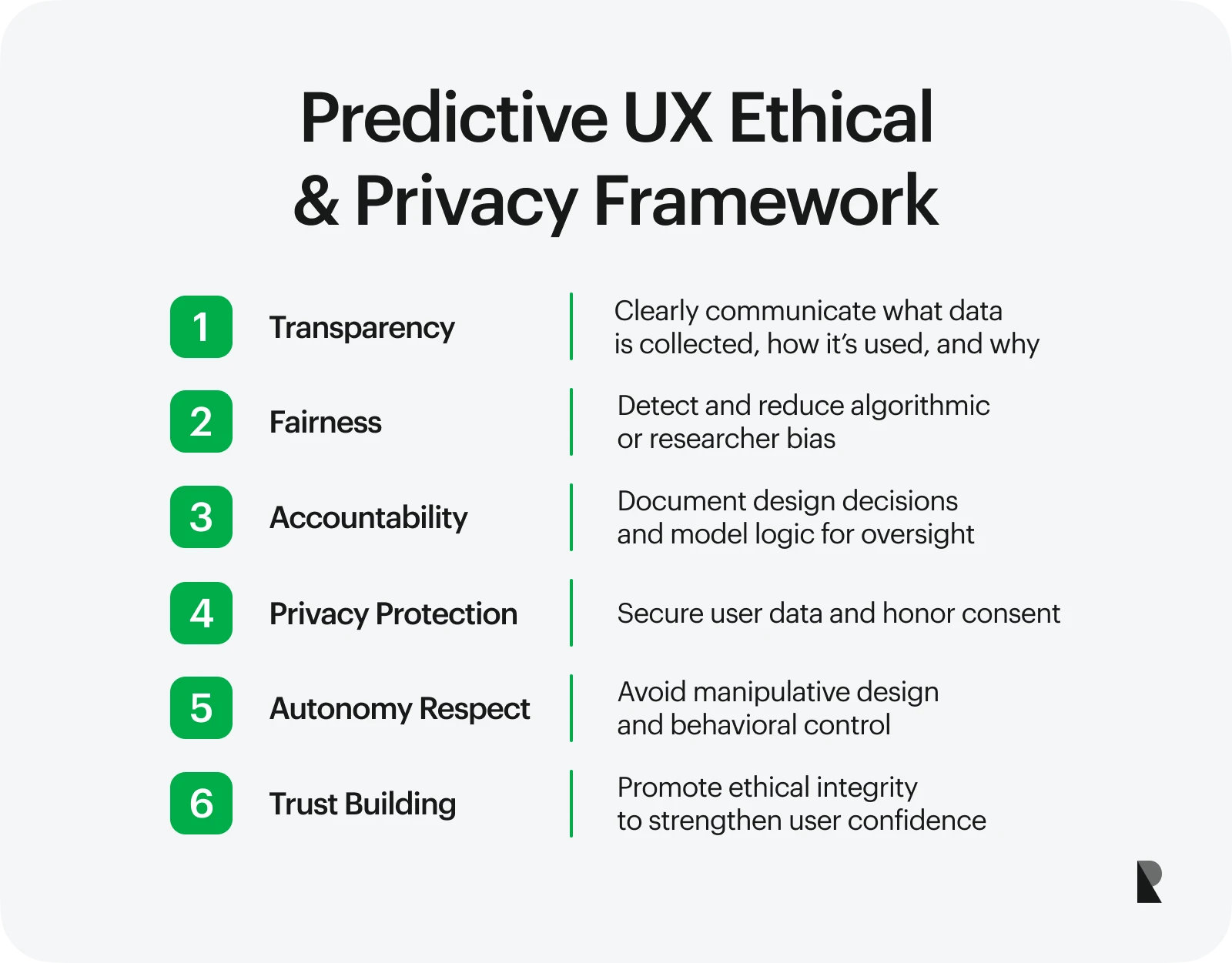
Ethical design should always be considered when working with predictive models. Some significant ethical concerns are discussed below.
Data collection and consent transparency
Every predictive UX design system starts with data collection, where real data about the behaviors of real users is gathered and analyzed. Therefore, obtaining user consent and being transparent about data collection and analysis is an essential ethical design consideration.
Organizations that emphasize honesty and transparency always build strong and long-lasting relationships. This is why when businesses consider hiring top UX design firms, their commitment to ethical design is a significant factor.
Algorithmic bias and manipulation risks
No data is free of bias, and no model is free of algorithmic bias. Therefore, it is essential to consider the bias of researchers and the built-in bias of predictive models when employing predictive UX design. Designers and researchers should always reflect on the intended and unintended biases in the design process.
Data can also be manipulated and distorted, thus delivering a wrong message. This can induce privacy and autonomy risks, promote stereotypes, and manipulate user behavior. Being cognizant of this concern is also essential when working with predictive models.
Proactive vs. Reactive Design
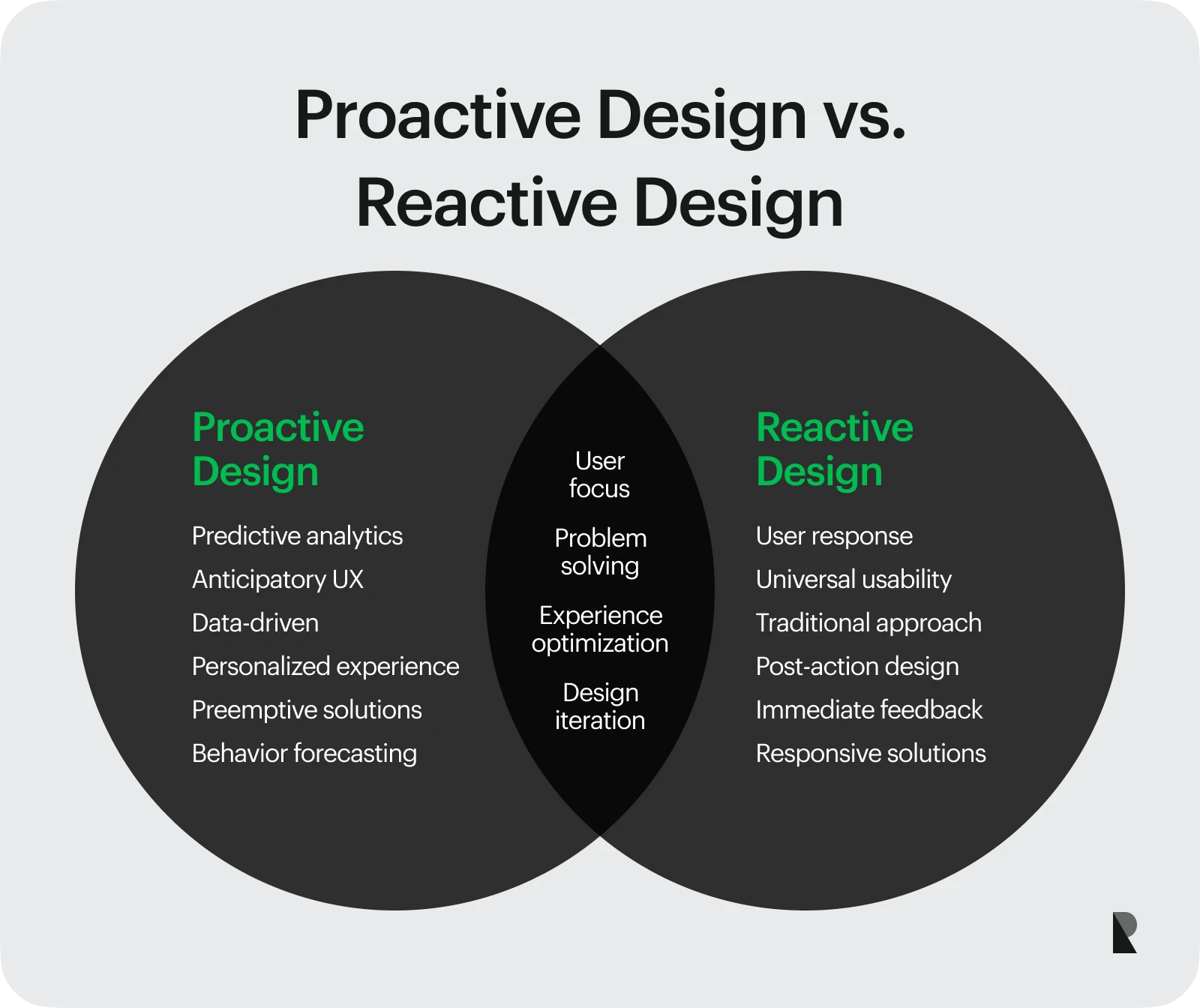
When we categorize design approaches, there are two broad classifications. Proactive design uses predictive analytics and predictive models to anticipate users’ needs, while reactive design waits for the users’ input. Understanding their differences is important.
Anticipatory vs. Responsive UX
Proactive UX, drawing from predictive models, focuses on anticipation. This approach aims to deliver recommendations and solutions to users before they even request them. Thus, predictive UX is anticipatory in nature.
On the other hand, a reactive approach to UX design is responsive. Reactive design offers solutions only after the users ask for them or take action to reach the solutions.
Data-Driven personalization vs. Universal usability
Proactive UX takes a data-driven approach to predict when users take specific actions. By doing so, designers can create personalized and tailored solutions for users based on their behaviors and preferences.
Reactive UX, on the contrary, takes a traditional approach to design and aims to deliver universal usability. The goal is not to create personalized experiences for all users but a usable and valuable solution for all.
Both proactive and reactive UX design have their own utility, but designers must understand the differences well. The table below lists some contrasting factors.
| Factor | Predictive (Proactive) UX | Traditional (Reactive) UX |
|---|---|---|
| User need | Anticipated in advance using predictive analytics | Addressed only after being expressed by users |
| Personalization | Driven by predictive models and behavior data | One-size-fits-all approach |
| Timing | Can predict when users need help | Waits for user input |
| Efficiency | Reduces effort, shortens journeys | Often requires multiple steps |
| Flexibility | Adapts in real time | Static and slower to change |
Tools and Technologies Powering Predictive UX
User experience designers and researchers require several tools to create personalized context and tailored experiences for the audience. The tools and technologies available to designers help them harness predictive algorithms and improve user experience.
What are some important tools and technologies powering predictive UX design?
Some important tools and technologies powering predictive UX design are as follows.
- Machine learning
- Behavioral analytics
- Recommendation systems
- Google Analytics
- Mixpanel
- Adobe Sensei
Core technologies
Some core technologies are at the heart of predictive UX. These technologies help turn data into actionable insights and dynamically tailor experiences.
- Machine learning allows systems to recognize patterns and continuously refine predictive models.
- Behavioral analytics tracks interactions to provide insights that can help guide predictive algorithms.
- Recommendation systems leverage these insights and deliver personalized content.

Tools and Technologies for Predictive UX Design (Image Source)
Examples: Google Analytics, Mixpanel, Adobe Sensei
Some essential tools demonstrate how predictive analytics are applied in real-world design solutions. These tools provide data and insights leading to better user experiences.
- Google Analytics tracks user behavior, gathers essential demographic information, and identifies trends that can serve as excellent input for predictive models.
- Mixpanel: Mixpanel is another important tool for monitoring user actions in apps. This can lead to building predictive models and forecasting user behavior.
- Adobe Sensei: Adobe Sensei uses predictive algorithms to deliver personalized content and improve the quality of digital interactions.
Best Practices for Predictive UX
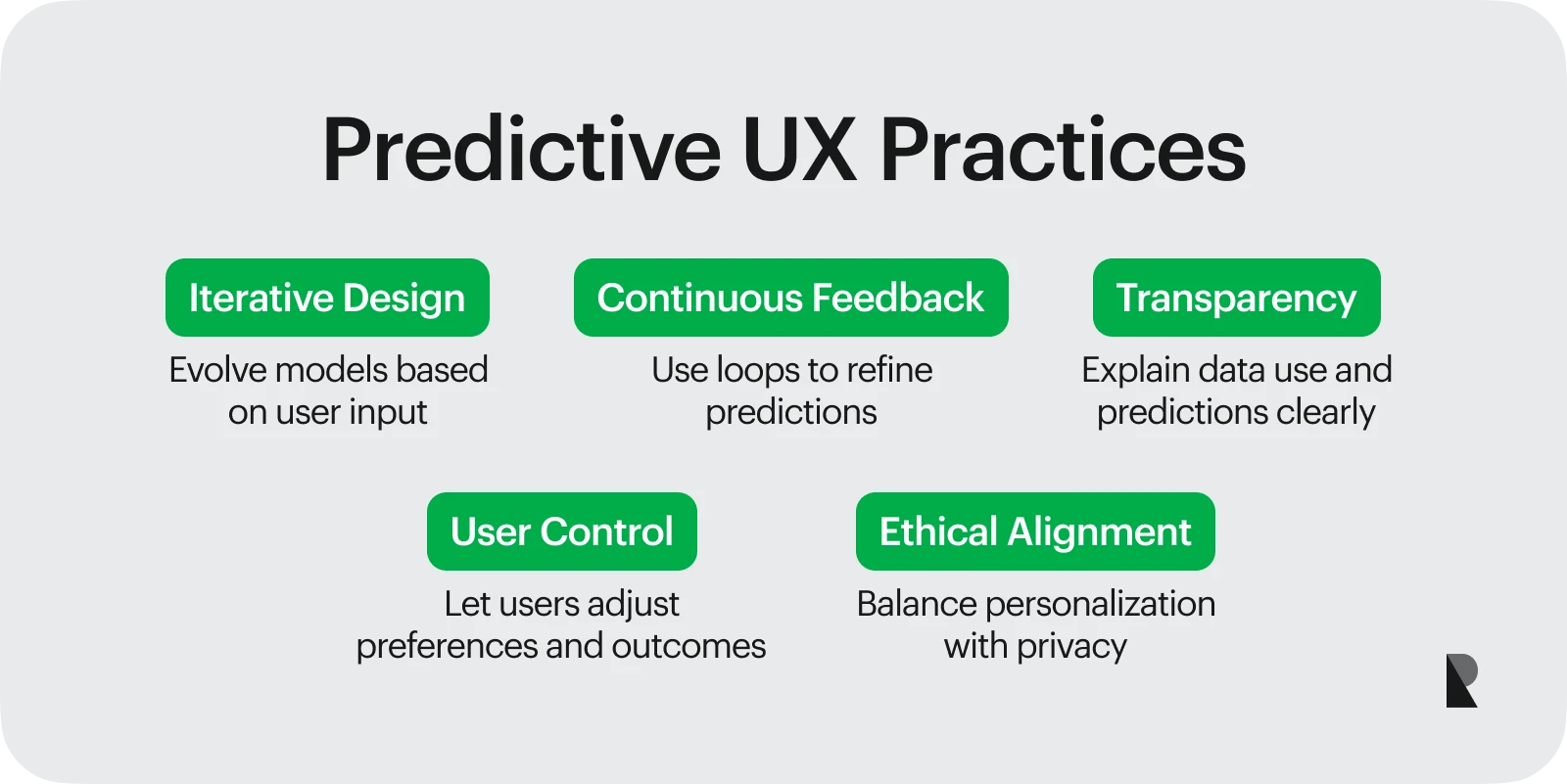
Designers should follow some best practices to ensure that predictive analytics is leveraged appropriately and predictive models are deployed effectively. Focusing on the fundamental principles of UX design, transparency, and iteration can help create better user experiences.
Continuous user feedback and adjustments
User feedback is an essential part of any design approach. Continuous feedback loops can only improve predictive models, which learn from users’ behavior and input and help recommender systems make informed predictions.
Feedback loops also add to the iterative nature of design, where sophisticated systems learn from the positive feedback and take users’ struggles and pain points. By incorporating feedback into user experience, designers can ensure that predictive analytics constantly support better solutions.
Transparency in predictions and controls
It is also essential to consider users' privacy concerns when providing recommendations and delivering personalized content. Design systems must be transparent about the type of data they gather and how they use it.
Clear explanations must be provided to the users about why specific data is gathered. The users should also have autonomy and control over their decisions, so they can modify predictions if and when necessary.
Challenges in Implementing Predictive UX
Implementing predictive UX design can be challenging. Designers need to be aware of certain hurdles and complications when implementing predictive models. Users are likely to trust designs that are good at predictions and also consider users’ concerns.
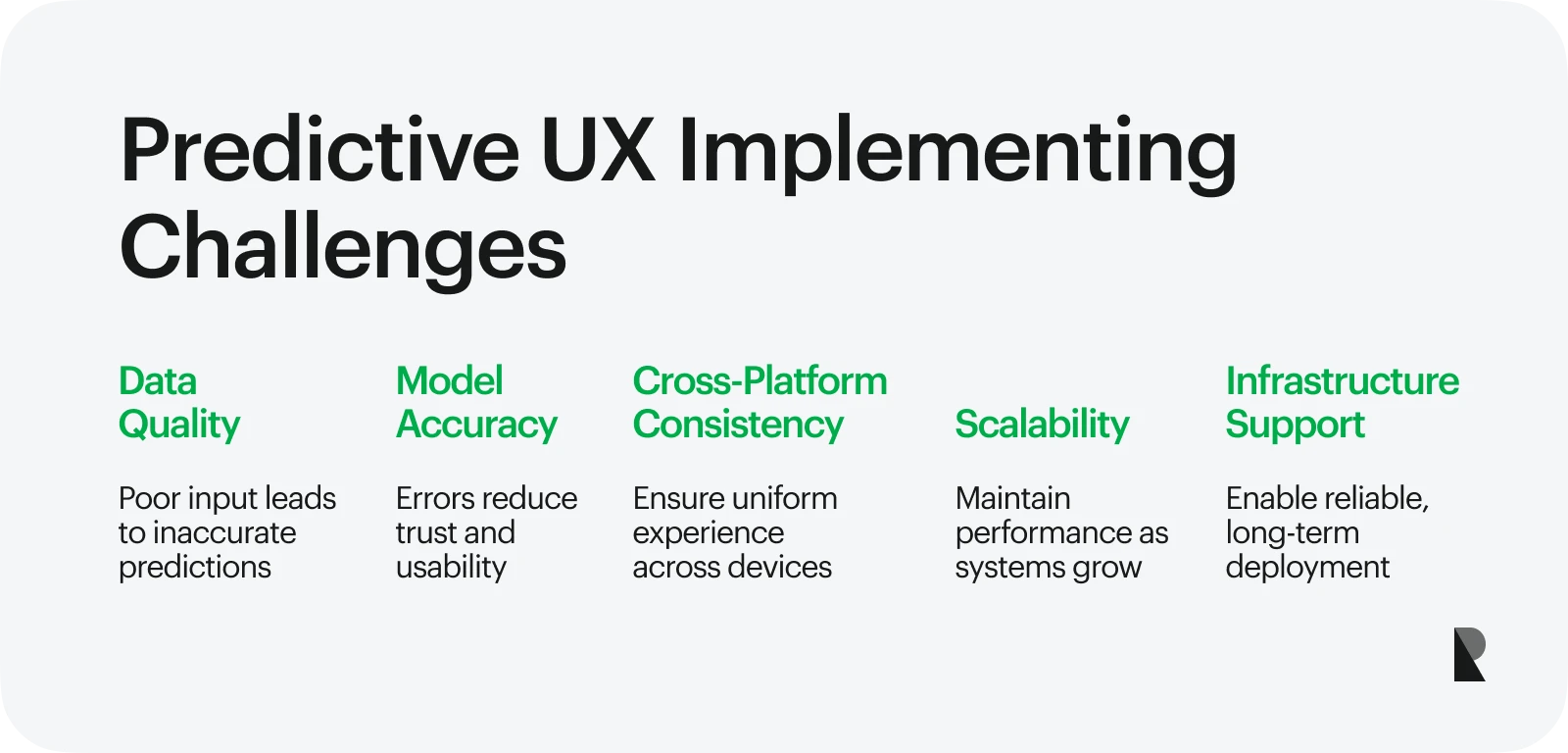
Data quality and model accuracy
The success of any predictive model depends on the quality of data and the accuracy of predictions. A model that gives wrong recommendations and does not anticipate users' needs correctly is highly likely to fail. Therefore, data quality is essential for the success of predictive UX design.
Cross-platform consistency
Another key element to consider in predictive UX is cross-platform consistency. For a user to trust a design, the interactions must be consistent across devices and platforms. A consistent design helps users navigate complex interactions with ease and enhances the overall user experience.
Scalability and infrastructure
Modern digital designs cannot succeed without a plan to scale the product or service. If the infrastructural support is insufficient over time or the design fails to meet the changing demands of users, designs can fail in no time. This also applies to predictive UX design, where scalability is always a critical factor.
Conclusion: Predictive UX as a Design Imperative
Predictive UX design represents a paradigm shift in how digital experiences are created, delivered, and managed. Using predictive models and analytics, UX researchers and designers can anticipate users' needs and streamline interactions. Such an approach is not reactive in nature and helps create intuitive real-world experiences.
However, when employing predictive analytics and predictive models, ethical design principles and design justice must be considered. In this approach to UX design, transparency, privacy, and autonomy should always be prioritized.
Predictive UX design helps create usable, practical, and intuitive products and services that can help improve the lives of the target audience.
Oct 13, 2025
